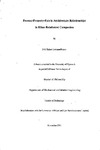PROCESS-PROPERTY-FABRIC ARCHITECTURE RELATIONSHIPS IN FIBRE-REINFORCED COMPOSITES
| dc.contributor.author | PEARCE, NEIL ROBERT LEWARNE | |
| dc.contributor.other | Faculty of Science and Engineering | en_US |
| dc.date.accessioned | 2013-11-05T11:03:41Z | |
| dc.date.available | 2013-11-05T11:03:41Z | |
| dc.date.issued | 2001 | |
| dc.identifier | NOT AVAILABLE | en_US |
| dc.identifier.uri | http://hdl.handle.net/10026.1/2596 | |
| dc.description.abstract |
The use of fibre-reinforced polymer matrix composite materials is growing at a faster rate than GDP in many countries. An improved understanding of their processing and mechanical behaviour would extend the potential applications of these materials. For unidirectional composites, it is predicted that localised absence of fibres is related to longitudinal compression failure. The use of woven reinforcements permits more effective manufacture than for unidirectional fibres. It has been demonstrated experimentally that compression strengths of woven composites are reduced when fibres are clustered. Summerscales predicted that clustering of fibres would increase the permeability of the reinforcement and hence expedite the processing of these materials. Commercial fabrics are available which employ this concept using flow-enhancing bound tows. The net effect of clustering fibres is to enhance processability whilst reducing the mechanical properties. The effects reported above were qualitative correlations. Gross differences in the appearance of laminate sections are apparent for different weave styles. For the quantification of subtle changes in fabric architecture, the use of automated image analysis is essential. Griffm used Voronoi tessellation to measure the microstructures of composites made using flow-enhancing tows. The data was presented as histograms with no single parameter to quantify microstructure. This thesis describes the use of automated image analysis for the measurement of the microstructures of woven fibre-reinforced composites, and pioneers the use of fractal dimensions as a single parameter for their quantification. It further considers the process-property- structure relationships for commercial and experimental fabric reinforcements in an attempt to resolve the processing versus properties dilemma. A new flow-enhancement concept has been developed which has a reduced impact on laminate mechanical properties. | en_US |
| dc.description.sponsorship | University of Bristol and Carr Reinforcements Limited | en_US |
| dc.language.iso | en | en_US |
| dc.publisher | University of Plymouth | en_US |
| dc.title | PROCESS-PROPERTY-FABRIC ARCHITECTURE RELATIONSHIPS IN FIBRE-REINFORCED COMPOSITES | en_US |
| dc.type | Thesis | |
| plymouth.version | Full version: final and full version as approved by the examiners at the time of the award of your degree | en_US |
| dc.identifier.doi | http://dx.doi.org/10.24382/3219 |
Files in this item
This item appears in the following Collection(s)
-
01 Research Theses Main Collection
Research Theses Main


